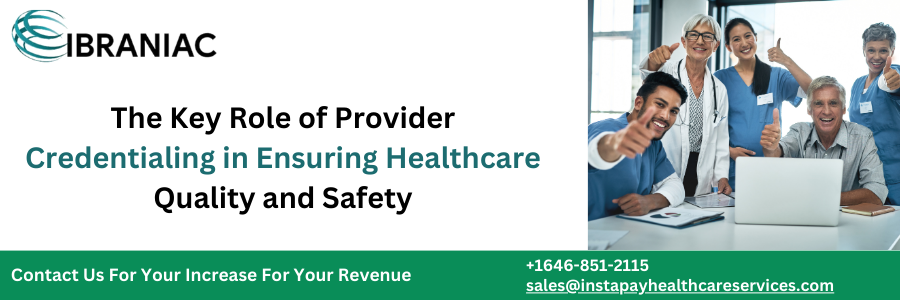
The Key Role of Provider Credentialing in Ensuring Healthcare Quality and Safety
by admin | March 06, 2024 | 0 comments,
1) Introduction :
In the realm of healthcare, ensuring best and protection stands paramount. Provider credentialing emerges as a cornerstone in achieving those objectives. Let's delve into the important thing facets of this critical process.
2) Definition of Provider Credentialing :
Provider credentialing refers to the rigorous assessment and validation of healthcare professionals' qualifications, experience, and competency. It entails verifying credentials which includes education, training, licensure, and certifications.
3) Importance of Healthcare Quality and Safety :
The provision of exceptional healthcare services is non-negotiable. Patient safety hinges at the competence and reliability of healthcare providers. Provider credentialing services as a crucial mechanism in upholding these standards.
Understanding Provider Credentialing
4) What is Provider Credentialing?
Provider credentialing includes the systematic assessment of healthcare practitioners' qualifications to make sure they meet industry standards. This technique applies to diverse healthcare settings, which include hospitals, clinics, and controlled care organizations.
5) Why is Provider Credentialing Important?:
Provider credentialing performs a pivotal position in safeguarding affected person well-being. By verifying the credentials and competence of healthcare specialists, it mitigates the danger of scientific errors, malpractice, and substandard care.
Process of Provider Credentialing
6) Steps Involved in Provider Credentialing
- Application Submission : Healthcare providers post complete packages detailing their instructional background, education, and licensure.
- Primary Source Verification : Credentialing committees verify the authenticity of supplied statistics thru direct contact with issuing institutions.
- Credential Review : A thorough assessment of the applicant's qualifications and revel in is conducted to make certain compliance with organizational requirements.
- Peer Review : Peer critiques can be employed to evaluate medical competence and ethical behavior.
- Decision Making : Based on the findings of the credentialing procedure, choices concerning company privileging and community participation are made.
7) Common Challenges Faced
- Documentation Errors : Incomplete or misguided documentation can impede the credentialing process.
- Credentialing Backlogs : Delays in processing programs can disrupt healthcare delivery and revenue cycles.
- Regulatory Compliance : Adherence to evolving regulatory requirements poses a chronic undertaking for healthcare organizations.
Benefits of Provider Credentialing
8) Enhancing Healthcare Quality and Safety :
Provider credentialing ensures that only qualified and capable experts are entrusted with patient care duties. This complements clinical consequences and fosters patient agree with and pleasure
9) Reducing Medical Errors :
By carefully vetting healthcare providers, credentialing minimizes the likelihood of mistakes, complications, and damaging occasions. This contributes to a safer healthcare environment and promotes fantastic affected person experiences.
Importance of Compliance
Ensuring Regulatory Compliance :
Provider credentialing aligns healthcare practices with regulatory requirements and accreditation requirements. Compliance with these mandates is crucial for maintaining organizational integrity and popularity.
10) Mitigating Legal Risks :
Failure to stick to credentialing requirements can expose healthcare businesses to felony liabilities and reputational damage. Compliance with credentialing protocols mitigates those risks and guarantees felony due diligence.
Technology's Impact on Provider Credentialing
11) Role of Technology in Streamlining the Process :
Advancements in era have revolutionized provider credentialing, facilitating automation, digitization, and information integration. Electronic credentialing platforms streamline administrative tasks and enhance efficiency.
12) Advantages and Disadvantages of Technology :
- Advantages : Technology expedites credentialing strategies, improves statistics accuracy, and enhances accessibility and scalability.
- Advantages : Technology expedites credentialing strategies, improves statistics accuracy, and enhances accessibility and scalability.
- Disadvantages : Overreliance on era may additionally lead to statistics breaches, machine vulnerabilities, and consumer blunders. Additionally, technological obstacles can also disenfranchise certain demographics.
Ensuring Continuous Quality Improvement
13) Monitoring and Evaluation :
Continuous excellent improvement involves ongoing monitoring and assessment of credentialing procedures and effects. Regular audits and performance exams become aware of areas for enhancement and optimization.
14) Strategies for Continuous Improvement :
- Stakeholder Engagement : Involving stakeholders in decision-making fosters collaboration and innovation.
- Process Optimization : Streamlining workflows and leveraging automation gear beautify efficiency and productiveness.
- Training and Education : Continuous getting to know initiatives empower staff with up to date understanding and abilities, riding performance improvement.
Conclusion
In conclusion, provider credentialing services as a linchpin in making sure healthcare great and safety. By meticulously verifying the qualifications and competence of healthcare professionals, corporations uphold the very best standards of patient care and regulatory compliance.
FAQs
What is the role of provider credentialing in healthcare?
Provider credentialing ensures that healthcare specialists possess the considered necessary qualifications and talents to supply secure and high-quality care to patients.
How does provider credentialing contribute to patient safety?
By fastidiously vetting healthcare providers, credentialing minimizes the risk of medical errors, malpractice, and substandard care, thereby improving patient safety.
What are the challenges associated with provider credentialing?
Common challenges consist of documentation mistakes, credentialing backlogs, and the complexities of regulatory compliance.
How does technology impact provider credentialing processes?
Technology streamlines credentialing procedures via automation, digitization, and records integration, enhancing performance and accuracy.
What are the benefits of continuous quality improvement in credentialing?
Continuous high-quality development fosters ongoing enhancement and optimization of credentialing strategies, ensuring organizational effectiveness and compliance.
Why is compliance essential in provider credentialing?
Compliance with regulatory requirements and accreditation necessities mitigates prison risks, safeguards organizational integrity, and upholds patient trust.
Ready to elevate your healthcare standards? Contact Instapay Healthcare Services today at +1(646) 851- 2115 sales@instapayhealthcareservices.com Experience top-tier provider credentialing at affordable prices! Don't miss out on ensuring the highest quality and safety for your patients. Reach out now!